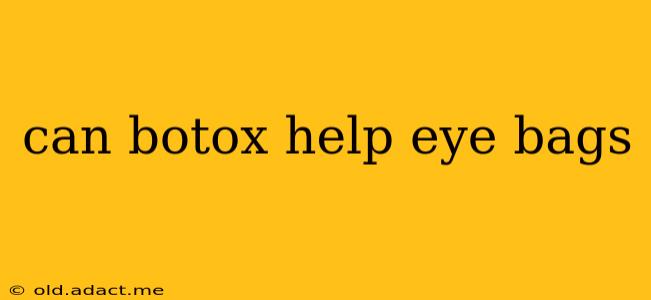Eye bags, those puffy under-eye areas, can be a significant source of concern for many. While often associated with aging, they can stem from various factors like genetics, lack of sleep, allergies, and fluid retention. Many people wonder if Botox, a popular cosmetic treatment, can provide a solution. The short answer is: Botox alone is not typically effective for treating eye bags. While it can address some contributing factors, it doesn't directly target the underlying cause of under-eye puffiness.
Let's delve deeper into why and explore effective alternatives.
Why Botox Isn't a Solution for Eye Bags
Botox works by temporarily paralyzing muscles, primarily focusing on wrinkle reduction. Eye bags, however, are primarily caused by excess fat, fluid retention, or weakened skin, not muscle activity. Therefore, Botox, which targets muscle contractions, doesn't address the root issue of eye bag formation.
What Causes Eye Bags? Understanding the Root Problem
Before exploring solutions, it's crucial to understand the different factors contributing to eye bags:
- Genetics: A family history of prominent eye bags often plays a significant role. This is often due to inherent structural factors.
- Aging: As we age, the skin around our eyes loses elasticity and collagen, leading to sagging and the appearance of bags.
- Fluid Retention: Fluid buildup under the eyes can make bags more pronounced, often worsened by factors like high sodium intake, lack of sleep, or allergies.
- Sun Exposure: Prolonged sun exposure damages collagen and elastin, contributing to skin laxity and under-eye bags.
- Lack of Sleep: Insufficient rest can exacerbate fluid retention, making eye bags more noticeable.
- Allergies: Inflammation from allergies can contribute to puffiness around the eyes.
Can Botox Help Indirectly? Addressing Related Concerns
While Botox won't directly reduce eye bags, it might help address related concerns that can indirectly improve the overall appearance of the under-eye area. For example:
- Addressing Fine Lines and Wrinkles: Botox can smooth fine lines and wrinkles around the eyes, making the skin look tighter and potentially making the eye bags appear less prominent in comparison. This is a matter of relative improvement, not a direct reduction of the bags.
- Improving Muscle Tone: In some cases, slight muscle laxity can contribute to the appearance of bags. Botox can improve muscle tone, indirectly reducing the prominence of the under-eye area. However, this is only a minor factor in most instances.
What are Effective Treatments for Eye Bags? Exploring Your Options
Several treatments are specifically designed to target eye bags and address the underlying causes:
- Filler Injections: Dermal fillers are injected under the eyes to volumize the area, reducing the appearance of hollowness and shadowing that often accentuates eye bags. These fillers typically last for several months to a year.
- Blepharoplasty (Eyelid Surgery): This surgical procedure removes excess fat and skin, directly addressing the physical causes of under-eye bags. It's a more permanent solution but involves surgery and recovery time.
- Laser Treatments: Certain laser therapies can stimulate collagen production, improving skin elasticity and reducing the appearance of eye bags over time.
- Lifestyle Changes: Improving sleep hygiene, reducing sodium intake, managing allergies, and protecting skin from sun damage can contribute to a reduction in puffiness and overall improvement in the under-eye area.
Frequently Asked Questions (FAQs)
Q: Will Botox make my eye bags worse?
A: Botox itself won't directly make eye bags worse, but if the underlying muscle tone is contributing to bag formation, it is possible that this effect might be lost and therefore bags might appear more noticeable. It's crucial to discuss your individual concerns and expectations with a qualified medical professional.
Q: What is the best treatment for eye bags?
A: The best treatment depends on several factors, including the severity of your eye bags, your overall health, and personal preferences. A consultation with a dermatologist or plastic surgeon can help determine the most suitable approach for you.
Q: How long do results last from different eye bag treatments?
A: The duration of results varies significantly depending on the treatment. Fillers typically last several months to a year, while blepharoplasty offers longer-lasting results. Lifestyle changes provide ongoing benefits if consistently followed.
Q: Are there any non-surgical options for eye bags?
A: Yes, several non-surgical options exist, including fillers, laser treatments, and lifestyle modifications.
In conclusion, while Botox can play a minor indirect role in improving the overall appearance of the under-eye area by targeting wrinkles and fine lines, it's not a primary treatment for eye bags. A consultation with a qualified professional is essential to determine the best course of action based on your individual needs and circumstances. Remember, managing expectations is key when considering any cosmetic treatment.
